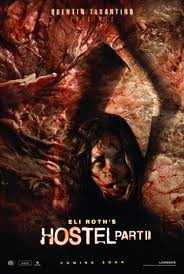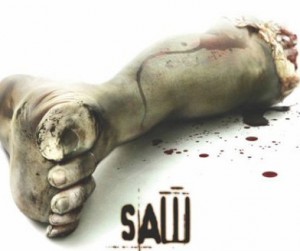
FEATURE: The Spectre of Violence
Violence in cinema has often provided a reliable wellspring for political controversy, religious condemnation, and served as an easy target for public outrage. While it may have passed under the radars of most politicians and moral guardians (at least for the moment ‘real’ violence seems a much more profitable cite for political gain), the release of Hostel: Part II last month briefly reignited discussion amongst several reviewers about the increasing levels of sadism in contemporary cinema.
 Perhaps somewhat predictably the film was met with an almost unanimous chorus of critical disapproval. In her review in The Daily Telegraph, Vicky Roach described Hostel: Part II as “an ugly, opportunistic tale of violence and vengeance”, an opinion largely echoed by both The Herald-Sun’s Leigh Paatsch (“repugnant dreck”) and At The Movies’ Margaret Pomeranz (“really sicko stuff in a lot of ways”). The Age’s Jim Schembri was even more scathing in his assessment of the film, labelling it, “an unfathomably vile piece of misogynist, sadistic pornography”.
Perhaps somewhat predictably the film was met with an almost unanimous chorus of critical disapproval. In her review in The Daily Telegraph, Vicky Roach described Hostel: Part II as “an ugly, opportunistic tale of violence and vengeance”, an opinion largely echoed by both The Herald-Sun’s Leigh Paatsch (“repugnant dreck”) and At The Movies’ Margaret Pomeranz (“really sicko stuff in a lot of ways”). The Age’s Jim Schembri was even more scathing in his assessment of the film, labelling it, “an unfathomably vile piece of misogynist, sadistic pornography”.
Yet while many critics were quick to decry the film as the pathological aberration of a sick mind (likening director Eli Roth to his filmic tormentors), or accused it of pandering to perverted audience desires, few attempted to position the film within a broader cultural or historical context.
It would be worth reiterating here that Hostel: Part II, far from signifying an isolated rupture of extreme cinematic violence, is but the latest addition to a growing list of ‘neo-sadist’ representations to emerge from within American cinema. From the relatively playful executions of the Final Destination trilogy, filmic violence, particularly within the horror genre, has followed an increasingly brutal and grotesque trajectory of late.
 Brought into prominence through the popular Saw trilogy, and carried on through films such as Hostel, and the remakes of House of Wax, The Texas Chainsaw Massacre, The Hills Have Eyes, and even closer to home, Wolf Creek, screen violence has become a nasty affair. Distinguished by an attention to intricately staged and meticulously rendered dismemberments and torturous scenarios: slashed Achilles tendons, blow-torched eyeballs, hack-sawed limbs, torsos stripped bare with razor wire, and heads torn open from the jaw backwards, this trend seems to draw its inspirations not simply from the tradition of the old Grand Guignol.
Brought into prominence through the popular Saw trilogy, and carried on through films such as Hostel, and the remakes of House of Wax, The Texas Chainsaw Massacre, The Hills Have Eyes, and even closer to home, Wolf Creek, screen violence has become a nasty affair. Distinguished by an attention to intricately staged and meticulously rendered dismemberments and torturous scenarios: slashed Achilles tendons, blow-torched eyeballs, hack-sawed limbs, torsos stripped bare with razor wire, and heads torn open from the jaw backwards, this trend seems to draw its inspirations not simply from the tradition of the old Grand Guignol.
It is possible I would argue, to draw a link between such instances of violence and recent cultural events such as the ongoing ‘War on Terror’. It bears remembering that the birth of ‘ultraviolence’ in American cinema (stemming from the revision of the Hays production code in 1966) coincided directly with those events of the Vietnam War. Back then American cinematic violence frequently allegorised the war (The Wild Bunch, Bonnie & Clyde, Soldier Blue), provoked by events such as the My Lai massacre and the Tet Offensive. Amidst the growing consciousness of cultural and political violence, such cinematic representations served as both a response to the turmoil, and a vehicle for social critique.
Given this history of violence and its ties to screen representation is it disingenuous to suggest a similar correlation exists for this current trend? Is it of more than a minor coincidence that all of these films have emerged not only after the events of 9/11, but even more pointedly since the beginning of the Iraq War? When you consider the iconic imagery that the conflict has thus far provided, (the beheading videos, the degrading ‘happy snaps’ from Abu Ghraib, and the torture of prisoners at Guantanamo Bay) is it really that much of a leap to Hostel? Unlike the frontline imagery that characterised the Vietnam War (body bags, napalm victims, disfigured vets), the Iraq War has at times looked like a ‘war without warring’: hijinks and hostages without the combat.
 Given the lack of images emanating from the Iraqi battlefront (even most documentaries have yet to capture the ‘true horror’ of what is actually taking place) you could be forgiven for thinking that the conflict is playing out like a virtual war without combatants. It’s a strange notion to have when you consider that some sources put the war’s fatality count somewhere in the vicinity of 70,000. With that much death going unsighted is it any wonder that some filmmakers in Hollywood have responded the way they have? For mine, the extreme violence of recent cinema seems more than just a deliberate marketing strategy, the latest screen fad, or an indicator of cultural depravity. I can’t help but think that these films are attempting to come to terms, at least culturally, with the horrors that are elsewhere being concealed.
Given the lack of images emanating from the Iraqi battlefront (even most documentaries have yet to capture the ‘true horror’ of what is actually taking place) you could be forgiven for thinking that the conflict is playing out like a virtual war without combatants. It’s a strange notion to have when you consider that some sources put the war’s fatality count somewhere in the vicinity of 70,000. With that much death going unsighted is it any wonder that some filmmakers in Hollywood have responded the way they have? For mine, the extreme violence of recent cinema seems more than just a deliberate marketing strategy, the latest screen fad, or an indicator of cultural depravity. I can’t help but think that these films are attempting to come to terms, at least culturally, with the horrors that are elsewhere being concealed.
That these ‘neo-sadist’ films are marked by a desire to ‘show the unshowable’ suggests to me, at least hypothetically speaking, the possibility of giving form to a repressed social and political conscience. It’s perhaps a shame then that in the attempts to imagine newer and more graphic orchestrations of violence that even the most rudimentary of cultural critiques has thus far ended up on the ‘cutting room’ floor.
4 Responses to “FEATURE: The Spectre of Violence”
RSS feed for comments on this post. TrackBack URI





Hmm. interesting point, but i would argue that, more specifically, these hyperviolent films are a result of feeling out of control.
I single out here particularly Hostel and Saw, in which there is a definite, distinct and crucial power element at play. The media as it is now both portrays and creates a world out of control, where villains and heroes no longer exist. Where a narrative of good triumphing over evil is no longer necessarily possible. In that world, a film in which a character is permitted to carry out the most gruesome violence against pretty much whoever happens by makes a lot of sense.
Undoubtedly, and the ongoing uncertainties that result from issues such as war, governmental control, national security, financial crises, patriotic scepticism etc. all contribute to the play of wanting reassert a sense of control through violent actions – which is really the cultural basis (unconscious or otherwise) of these foreign interventions.
Interesting point of view on this subject. I’m not sure whether I agree entirely, though.
CS, which part exactly did you disagree with? I’d be interested to hear your thoughts.